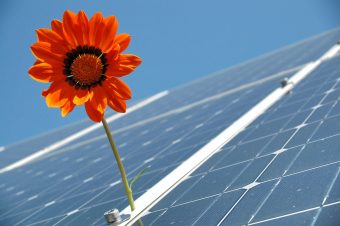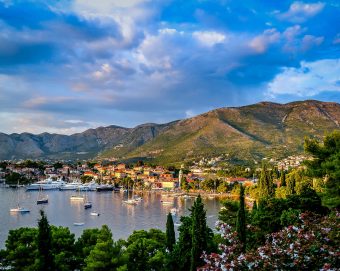
Millions of people flock to Malta to get roasted by the intense sun, but the Mediterranean island struggles to hit its solar power goals.

Despite being one of the EU’s sunniest countries, Malta doesn’t have a lot of space. With 413,000 people crammed into only 316 square kilometers — the densest population in the EU — it’s difficult to find enough space to set up solar panels.
Malta must triple its solar power capacity by the end of the decade to meet its renewable energy targets, but it also has to make sure its solar power projects aren’t so ugly or intruding that they scare off lucrative tourists or cover up the country’s limited amount of agricultural land.
Overall, Malta is supposed to have 10 percent of its energy come from renewables by 2020, and its sluggish pace is alarming the European Commission, which called on the government “to assess whether their policies and tools are sufficient and effective in meeting their renewable energy objectives.”
In 2015, only 5 percent of Malta’s energy came from renewable sources, one of the lowest shares in the EU. Of that, only 30 percent came from photovoltaics, or PV, while 13.4 percent came from solar water heaters, said Daniel Azzopardi, the CEO of the Energy and Water Agency, the body that implements government energy policies. The rest came from biofuels.
“We are blessed with a very high solar index, however we are unlucky when it comes to geography,” Azzopardi said.
Wind power isn’t a viable option because Maltese waters get very deep very quickly, a hurdle for offshore wind towers. Environmental concerns also played a big role in closing the door on the technology — a planned offshore wind farm was scrapped after an assessment found it would harm marine life. Onshore wind farms could have interfered with the island’s international airport, according to Malta’s updated renewable energy action plan.
Despite the lack of space, solar is the government’s best bet to meet its end-of-decade target.
The drive to expand renewables is part of a broader transformation of Malta’s energy mix — something that’s a challenge for islands in general. During its presidency of the Council of the EU, which ends Friday, Malta spearheaded an initiative to encourage the promotion of clean energy on islands.
Its work is in its infancy: 14 EU countries signed a political declaration in Valletta at the end of May calling for the establishment of a forum of government officials, investors, civil society groups and universities meant to help islands access renewable energy.
Until recently, Malta was isolated from the European power grid, almost completely dependent on oil to power its electricity plants and heat its homes.
It began receiving liquefied natural gas at the beginning of this year through a new LNG terminal and is now linked up to the Sicilian electricity grid through a €182 million connector that went online in 2015. A gas pipeline to Sicily is also in the works.
Malta’s total installed solar power capacity at the end of last year accounted for about 90 megawatts, or about 1.5 percent of its energy. The goal is to ramp that up to 4.7 percent by the end of the decade — or almost half of its total renewables energy target — according to Malta’s national renewable energy plan, which was first adopted in 2010, then completely revamped and adopted again earlier this year.
Malta “has a tremendous opportunity, but has not fulfilled it yet,” said James Watson, the CEO of Solar Power Europe, an industry lobby group in Brussels.
Residential roofs provide another option, but drone footage over Malta shows rows of houses with Mediterranean-style flat roofs, with only the occasional glint of a solar installation.
That’s because closely packed houses are different heights, so one building often shades the roof of another.
“If my neighbor decided to build another building 10 meters higher than mine, my panels will be in the shade,” said Mark Bajada, managing director of Bajada Energy, which controls 40 percent of the country’s solar power market.

The government is trying to solve that with a new community plan that allows people to invest in solar farms located elsewhere on the island and reap the benefits through lower power bills. But the scale so far is tiny: It serves 350 families so far, Azzopardi said.
Saint Julian’s, a popular resort town north of the capital Valletta, exemplifies the challenge of accommodating renewables and tourists. Visitors soak up the sun on neatly arranged lounge chairs facing a pool and the bay — but the idyllic scene is marred by several rows of solar panels clustered near the water.
“Our main income is coming from tourism,” Bajada said. “We have to be very, very careful not to have a visual impact with ugly-looking structures.” Tourists injected €1.7 billion in the Maltese economy in 2016, according to Maltese media.
The government is aware that solar panels can be a blight.
“This proliferation of [PV] systems is generating increasing concern on their visual impact affecting the urban landscape and skyline in village cores,” the government report said.
That’s why Malta’s new solar farm policy calls for setting up panels in places far from tourists like old garbage dumps or on post-industrial brownfield sites. It also prioritizes large-scale PV rooftops on car parks and on industrial areas.
“Malta is a place where people value the land that we have,” said Konrad Mizzi, Malta’s former energy minister. “Environmental groups are very strong … so we have to be innovative in our ways.”
The government has been sluggish in implementing its new policy, Bajada said. The solar farm plan is still being worked on, but the recent election and ensuing cabinet reshuffle delayed its adoption.
“It’s ridiculous,” Bajada said. “We have been waiting for the last four, five years … It’s not about this government or the former government; they both promised but are still struggling to see it done.”
Another option is integrated PV panels, which are built into walls. They don’t generate as much power as traditional solar panels because they don’t spend as much time facing the sun, but they aren’t as ugly and also help boost a building’s energy efficiency, said Bajada, calling them “aesthetically sexy.”
Industrial users are already starting to use them. About 20 minutes outside of Valletta, the headquarters of the local branches of toymaker Playmobil and media equipment manufacturer Baxter shimmer in the blazing sun, both buildings banded by dark solar wall panels just above the windows, providing shade during the hot Maltese days.
That’s “special engineering,” said Bajada, whose company installed the panels.
Bajada said integrated PV panels are still more expensive than the regular rooftop ones, which makes them less popular.
Falling solar panel prices make PV schemes of all kinds more attractive, and the government ramped up its solar power plans after it found that the amount of government support needed is diminishing.
“It was a bit of a ‘wait and see’ attitude,” Watson said.
“The drastic reduction in the prices of PV panels has provided an alternative, cost-effective path for Malta to reach its 2020 [renewable energy] target,” the national report said.
But that won’t solve Malta’s main problem — a lack of space. The government’s national solar policy report notes that “once brown fields cannot be exploited further, it will be impractical for Malta to increase its PV renewable generation.”
Source: politico.eu

